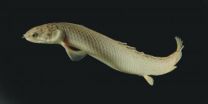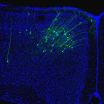(Press-News.org) VIDEO:
Polypterus senegalus walks across a sandy substrate. Fish use their fins and body in combination to move across a terrestrial substrate. Fins are planted one after the other to lift...
Click here for more information.
About 400 million years ago a group of fish began exploring land and evolved into tetrapods – today's amphibians, reptiles, birds, and mammals. But just how these ancient fish used their fishy bodies and fins in a terrestrial environment and what evolutionary processes were at play remain scientific mysteries.
Researchers at McGill University published in the journal Nature, turned to a living fish, called Polypterus, to help show what might have happened when fish first attempted to walk out of the water. Polypterus is an African fish that can breathe air, 'walk' on land, and looks much like those ancient fishes that evolved into tetrapods. The team of researchers raised juvenile Polypterus on land for nearly a year, with an aim to revealing how these 'terrestrialized' fish looked and moved differently.
"Stressful environmental conditions can often reveal otherwise cryptic anatomical and behavioural variation, a form of developmental plasticity", says Emily Standen, a former McGill post-doctoral student who led the project, now at the University of Ottawa. "We wanted to use this mechanism to see what new anatomies and behaviours we could trigger in these fish and see if they match what we know of the fossil record."
Remarkable anatomical changes
The fish showed significant anatomical and behavioural changes. The terrestrialized fish walked more effectively by placing their fins closer to their bodies, lifted their heads higher, and kept their fins from slipping as much as fish that were raised in water. "Anatomically, their pectoral skeleton changed to became more elongate with stronger attachments across their chest, possibly to increase support during walking, and a reduced contact with the skull to potentially allow greater head/neck motion," says Trina Du, a McGill Ph.D. student and study collaborator.
"Because many of the anatomical changes mirror the fossil record, we can hypothesize that the behavioural changes we see also reflect what may have occurred when fossil fish first walked with their fins on land", says Hans Larsson, Canada Research Chair in Macroevolution at McGill and an Associate Professor at the Redpath Museum.
Unique experiment
The terrestrialized Polypterus experiment is unique and provides new ideas for how fossil fishes may have used their fins in a terrestrial environment and what evolutionary processes were at play.
Larsson adds, "This is the first example we know of that demonstrates developmental plasticity may have facilitated a large-scale evolutionary transition, by first accessing new anatomies and behaviours that could later be genetically fixed by natural selection".
INFORMATION:
The study was conducted by Emily Standen, University of Ottawa, and Hans Larsson, Trina Du at McGill University.
This study was supported by the Canada Research Chairs Program, Natural Sciences and Engineering Research Council of Canada (NSERC) and Tomlinson Post-doctoral fellowship.
Contact:
Cynthia Lee
cynthia.lee@mcgill.ca
Relations avec les médias | Media Relations
Université McGill | McGill University
T. 514.398.6754
http://www.mcgill.ca/newsroom/
http://twitter.com/#!/McGilluMedia
Walking fish reveal how our ancestors evolved onto land
2014-08-27
ELSE PRESS RELEASES FROM THIS DATE:
NIH issues finalized policy on genomic data sharing
2014-08-27
The National Institutes of Health has issued a final NIH Genomic Data Sharing (GDS) policy to promote data sharing as a way to speed the translation of data into knowledge, products and procedures that improve health while protecting the privacy of research participants. The final policy was posted in the Federal Register Aug. 26, 2014 and published in the NIH Guide for Grants and Contracts Aug. 27, 2014.
Starting with funding applications submitted for a Jan. 25, 2015, receipt date, the policy will apply to all NIH-funded, large-scale human and non-human projects that ...
Scientists looking across human, fly and worm genomes find shared biology
2014-08-27
Researchers analyzing human, fly, and worm genomes have found that these species have a number of key genomic processes in common, reflecting their shared ancestry. The findings, appearing Aug. 28, 2014, in the journal Nature, offer insights into embryonic development, gene regulation and other biological processes vital to understanding human biology and disease.
The studies highlight the data generated by the modENCODE Project and the ENCODE Project, both supported by the National Human Genome Research Institute (NHGRI), part of the National Institutes of Health. ...
Worms, flies and humans... Our common genomic legacy, key to understanding cell biology
2014-08-27
This news release is available in Spanish. Genomes accumulate changes and mutations throughout evolution. These changes have resulted in a huge diversity of species and in different traits between us. But animal cells, whether they are from a fly or a human, work similarly: they have common molecular mechanisms.
Based on this premise, an international consortium with participation of scientists from the Centre for Genomic Regulation in Barcelona have compared the transcriptome (the RNA complement of a species' cell) of different animal species. They used data from ...
Snowfall in a warmer world
2014-08-27
If ever there were a silver lining to global warming, it might be the prospect of milder winters. After all, it stands to reason that a warmer climate would generate less snow.
But a new MIT study suggests that you shouldn't put your shovels away just yet. While most areas in the Northern Hemisphere will likely experience less snowfall throughout a season, the study concludes that extreme snow events will still occur, even in a future with significant warming. That means that, for example, places like Boston may see less snowy winters overall, punctuated in some years ...
Researchers change the emotional association of memories
2014-08-27
By manipulating neural circuits in the brain of mice, scientists have altered the emotional associations of specific memories. The research, led by Howard Hughes Medical Institute investigator Susumu Tonegawa at the Massachusetts Institute of Technology (MIT), reveals that the connections between the part of the brain that stores contextual information about an experience and the part of the brain that stores the emotional memory of that experience are malleable.
Altering those connections can transform a negative memory into a positive one, Tonegawa and his MIT colleagues ...
Witnessing the early growth of a giant
2014-08-27
Elliptical galaxies are large, gas-poor gatherings of older stars and are one of the main types of galaxy along with their spiral and lenticular relatives. Galaxy formation theories suggest that giant elliptical galaxies form from the inside out, with a large core marking the very first stages of formation.
However, evidence of this early construction phase has eluded astronomers — until now.
Astronomers have now spotted a compact galactic core known as GOODS-N-774, and nicknamed Sparky [1]. It is seen as it appeared eleven billion years ago, just three billion years ...
Stop and listen: Study shows how movement affects hearing
2014-08-27
DURHAM, N.C. -- When we want to listen carefully to someone, the first thing we do is stop talking. The second thing we do is stop moving altogether. This strategy helps us hear better by preventing unwanted sounds generated by our own movements.
This interplay between movement and hearing also has a counterpart deep in the brain. Indeed, indirect evidence has long suggested that the brain's motor cortex, which controls movement, somehow influences the auditory cortex, which gives rise to our conscious perception of sound.
A new Duke study, appearing online August 27 ...
NASA sees massive Marie close enough to affect southern California coast
2014-08-27
Two NASA satellites captured visible and infrared pictures that show the massive size of Hurricane Marie. Marie is so large that it is bringing rough surf to the southern coast of California while almost nine hundred miles west of Baja California.
On August 26 at 19:05 UTC (3:05 p.m. EDT) NASA's Terra satellite captured a visible image of Hurricane Marie drawing in the small remnants of Karina. Marie is over 400 miles in diameter, about the distance from Washington, D.C. to Boston, Massachusetts. Hurricane force winds extend outward up to 60 miles (95 km) from the center ...
Scripps Research Institute scientists link alcohol-dependence gene to neurotransmitter
2014-08-27
LA JOLLA, CA – August 27, 2014 – Scientists at The Scripps Research Institute (TSRI) have solved the mystery of why a specific signaling pathway can be associated with alcohol dependence.
This signaling pathway is regulated by a gene, called neurofibromatosis type 1 (Nf1), which TSRI scientists found is linked with excessive drinking in mice. The new research shows Nf1 regulates gamma-aminobutyric acid (GABA), a neurotransmitter that lowers anxiety and increases feelings of relaxation.
"This novel and seminal study provides insights into the cellular mechanisms of ...
Expression of privilege in vaccine refusal
2014-08-27
DENVER (August 27, 2014) – Not all students returning to school this month will be up to date on their vaccinations. A new study conducted by Jennifer Reich, a researcher at the University of Colorado Denver, shows that the reasons why children may not be fully vaccinated depends on the class privilege of their mothers.
According to the National Network for Immunization Information, three children per 1000 in the U.S. have never received any vaccines, with almost half of all children receiving vaccines later than recommended. The number of unvaccinated children has led ...






